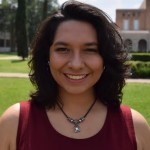
Brianna Garcia
Rice University
Freshman, Chemical & Biomolecular Engineering with Materials Science & Nanoengineering Focus
Expected Graduation: May 2019
Host Lab in Japan: Maruyama-Chiashi Lab, University of Tokyo
Research Project Abstract & Poster: Lithography-Free Fabrication of Transparent Conductive Single-Walled Carbon Nanotube Films![]()
Why Nakatani RIES?
The Nakatani RIES Fellowship is an unbelievable opportunity that will provide me with numerous experiences I would not have had otherwise. I applied with the intention of gaining research experience to complement my classroom learning, to practice problem solving more than on paper. I wanted to kick-start an active undergraduate research career in materials science, while further clarifying my interests within the field. Looking forward, I am excited to conduct research for the first time and gain in-depth knowledge about a cutting-edge aspect of science. I look forward to collaborating with an international team to gain a hands-on taste of materials science research. I am excited to travel in Asia and be immersed in a new culture for the first time. Finally, I look forward to eating new food, learning a new language, and meeting the new people with whom I will share these meals and words.
This program will provide me with such rich experiences of both science and culture. The Nakatani RIES Fellowship is a valuable opportunity to create an exchange between students of the U.S. and Japan, facilitating exploration in both research and travel. I am beyond grateful that I have the chance to participate in this program and strongly encourage other students to enrich their undergraduate education with the opportunities that this fellowship provides.
Goals for the Summer
- Garner a firm grasp on a specific area of modern materials science research
- Gain knowledge of the research process and technical skills for using equipment
- Develop a working knowledge of Japanese; enough to sustain a useful conversation
- Reaffirm and feed a passion for science
My favorite experience in Japan was… walking around the streets of Tokyo.
Before I left for Japan I wish I had… planned a clearer idea of things I wanted to do while in Japan.
While I was in Japan I wish I had… traveled outside of Tokyo more.
Meaning of Nakatani RIES – Post-Program
Nakatani RIES made for the most formative summer I have ever had. For me, it is one of those things that you look back and can’t quite make yourself totally believe actually happened. There are so many memories, so many unique and fond memories, that I am reminded of almost daily. Not just nostalgia, but there have been countless times in school or daily life that I have been faced with a challenge, and some experience from this summer has given me insight to work through the situation. When I am in need of motivation, I remind myself of all the hard work and long days I spent in the lab, and I have a renewed sense of capability. Lastly, Nakatani RIES gave me the opportunity to meet so many more people than I could have otherwise. Even just acquaintances, I have now interacted with so many more people across the world, which has naturally broadened me as a person and expanded my perspective. But above all, I am so grateful for the friends I have made through this program—Nakatinis!
Research Internship Overview
My research project was to develop an easier fabrication process for transparent conductive films from single-walled carbon nanotubes using self-assembled metal masks for selective catalyst deposition. This project gave me hands-on work with materials synthesis research in nanomaterials, which relates to my chosen focus of materials science within my chemical engineering degree. While I enjoyed my research project, this experience has helped me realize that I would like to work more on the large-scale side of engineering, perhaps processing or applications of nanotube materials more than experimental synthesis. However, I enjoyed working in an international lab, which I would consider doing again because of this experience.
My host lab was very large, and most people were part of a smaller group focused on a specific aspect of research, such as the graphene group or the solar cell group. I would say most interaction occurred within these groups, but there were still some overall lab activities. As far as my own research, I was more working a side project than actually joining anyone else’s research directly. For the first part of the summer, I worked closely with my mentor as he showed me how to operate equipment and handle samples, but after learning the techniques I would carry out the physical fabrication of the samples mostly on my own. However, I would still report to my mentors for next steps and guidance. My lab was very large and very international, so there was a large number and large variety of people to meet. Many of the lab members were very friendly, and it was nice to eat and have some conversation with other lab members.
Daily Life in Japan
Outside of the lab, I most frequently interacted with Chandni, forming our somewhat inseparable tomodachi pair. I’m grateful that I had such a close friend at the same university to meet up for meals or excursions on the occasional weekday. On the weekends, the other Tokyo-area Nakatani residents would meet up, sometimes with KIP students as well. On a more everyday basis, I also casually interacted with the housemates at my share house, which was interesting. They were all very international and opened my eyes even more to the realities of a global society. I made great friends with the late-night workers at the Lawson on my way home from the subway station—they’re the only ones who know the true extent of my onigiri, vegetable juice, and Kirin lemon tea addictions. I would say I did get to experience the Japanese college student diet of ramen, konbini foods, and wonderfully cheap cafeteria foods. As far as housing, my apartment was actually quite nice considering the difficulty of finding manageable Tokyo rentals. It was in Kuramae, a pretty residential area near the more happening Asakusa district.
My typical day started relatively late for a workday, although I still managed to get to lab before the majority of the lab mates. I would leave my house around 9:30 to walk a convenient minute to the subway station, ride a convenient 5-minute 3 stops down the Oedo line, and then walk an only slightly less convenient 15 minutes from Hongo-sanchome station to my engineering building. At the beginning of the internship, I would do some desk work while waiting for my mentor’s available times to work on our project, but after the first few weeks and my mentor’s diligent instruction, I was able to start working on fabricating samples whenever I needed to and the equipment was available. While I started off working 8-10 hour days, towards the end of the summer I would work closer to 12-14 hour days as we tried more and more process variations to achieve better samples. On the last weekend at lab, Chandni and I traveled to Nagano, although most weekends I would usually spend in various places around the Tokyo area.
Excerpts from Brianna’s Weekly Reports
- Week 01: Arrival in Japan
- Week 02: Trip to Akita
- Week 03: Noticing Similarities, Noticing Differences
- Week 04: First Week at Research Lab
- Week 05: Critical Incident Analysis – Life in Japan
- Week 06: Preparation for Mid-Program Meeting
- Week 07: Overview of Mid-Program Meeting & Research Host Lab Visit
- Week 08: Research in Japan vs. Research in the U.S.
- Week 09: Reflections on Japanese Language Learning
- Week 10: Interview with a Japanese Researcher
- Week 11: Critical Incident Analysis – In the Lab
- Week 12: Final Week at Research Lab
- Week 13: Final Report
- Tips for Future Participants
Week 01: Arrival in Japan
Although I was aware of cultural differences existing between Japanese and American cultures, I was still surprised (and continue to be surprised) by just how many differences there are. I see these cultural differences mainly in the public sphere and how people act in regards to other people’s perceptions. While in America, it seems more of a virtue to “not care what people think” and to take pride in being who you want to be. However, this seems very different in Japan, where it seems people gauge their actions based on how it affects and appears to others.
In reaction to Tokyo specifically, I am amazed by how organized it is. Everyone seems to walk with a purpose, exactly where they need to be. Everyone stands on the left side of the escalator and walks on the right. At the same time, people seem to know the social rules, and pretty much everyone sticks to them. While this makes for a smoothly running society, it is stressful to someone coming from the outside. While people are generally forgiving, it does sometimes feel like walking on eggshells. Because there is a right way to do things, it means there are plenty of wrong ways to do them too.
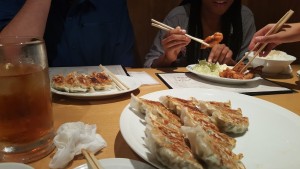
An overarching idea I continue to notice is the concept of convenience. I keep catching myself using the phrase “So kombini,” as in convenient (like the convenience stores). Along the same line of good organization, many aspects of Japan just make life more convenient for people. However, the flip side to this is that a heavy weight is placed on not inconveniencing others, which can be hard to be mindful of coming from an American standpoint. Although I thought myself a considerate person (by American standards), it really is difficult to be constantly aware of how you are affecting everyone around you.
I also noticed some little things that I expected to be different. Firstly, I expected Tokyo to have more diversity. Although I had heard that Japan largely was of a unified culture, I expected such a large metropolis as Tokyo to have a larger percentage of other peoples. However, this could just be the areas I’ve been to so far. Coming into Japan, I was expecting to naturally eat healthier in Japan because of the American “unhealthy” stereotype, but there aren’t as many vegetables and fruits as I would have thought, and it’s still common to eat foods like ramen and noodles. Although I had heard that Japanese fashion is nice and well put together, I’m still impressed everyday walking on the streets by the care that people take with their appearances. Finally, I had heard that Japan was safe in general, it still impresses me by just how safe it actually is. School kids walk around the streets on their own, and people leave their stuff knowing it will be there when they return.
I enjoyed my first week of language classes. This is my first experience in learning a language from scratch, so it is interesting to learn a system that is completely new to me. It is especially fun to relate Japanese to ideas I learned in a linguistics class last year. However, this new experience does mean it is easy for me to mix up words, especially because it seems there are such a small number of syllables just in different combinations, so the words often seem similar to me. Because Japanese is so different from English, there aren’t really any context clues or root words you can try using to figure things out. In addition, because the schedule is so packed, it seems difficult to find time to just sit down and reinforce the material. However, one method that is helping me remember Japanese words and phrases is to think of the meaning for each constituent part. As I learn more Japanese, hopefully I start building a body of Japanese context clues. For right now, one method I’m using is mnemonics to help me remember and differentiate the characters and words. Additionally, because I’m a visual learner, I take plenty of notes during class so I can hear, see, and write out the words and phrases, to take advantage of different methods of memory input. Although pretty English-centric, I would have to say my favorite thing about learning the Japanese characters is walking around Tokyo and seeing katakana that spells out Japanese-English words like basu (bus) or erebeetaa (elevator).
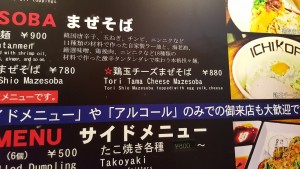
In addition to learning about Japanese society from living in Tokyo, the activities in Japanese Culture and Society have been helpful in introducing me to aspects of Japanese culture and explaining the driving concepts behind it. Out first talk from Packard-san was useful in noting the concepts of modesty and ambiguity, which I can see are highly relevant to Japanese society. This talk helped guide me to adopt these attitudes of deference and consideration; even if I don’t know exactly what to do in a situation, it will help to have an appropriate mindset. Nonetheless, I foresee myself possibly having difficulties with two concepts prevalent in Japanese society: ambiguity and hierarchy. Although I did not realize this before, I have been ingrained with American ideas of directness and equality. Ironically, I struggled to be “direct enough” by American standards, but now I think I will have trouble being “ambiguous enough” by Japanese standards. Additionally, the more informal atmosphere of American social structure has caused me to be wary of the strict Japanese hierarchy—I worry that I won’t always be mindful of the correct level of respect or politeness. I sense this especially in learning the language, where there is a wide spectrum of saying the same thing in varying degrees of politeness.
The following day, we had a discussion with KIP students about the U.S. presidential race. Through this, I realized that Japanese students knew a lot more about the U.S. than we did about Japan, even in matters that affected both of our countries. Another interesting idea that came up was the Japanese attitude toward preserving culture. In discussing TPP and free trade, the point of opening Japanese culture to other influences was brought up. Some Japanese modes of thought might choose to prioritize preserving culture over something that would benefit the country. For example, in the context of allowing in immigrants to combat the declining population, some would prefer not opening the country to heterogenization, even if it would benefit the economy or population dynamics. This value placed in a unified culture is quite different from the American emphasis on diversity.
The museum visit and sumo tournament were helpful in glimpsing Japanese culture from previous ages. Visiting the Edo-Tokyo Museum showed that some aspects of modern Japanese culture had roots in earlier times, such as strict hierarchy and social structure. I particularly enjoyed the sumo match. Not only was it amusing, but I appreciated how it connected sport and entertainment with spritituality and tradition.
Question of the Week
One question I have had about Japanese social culture is how it reconciles efficiency with ambiguity. It seems like there is an emphasis on streamlined systems, but the culture’s indirectness seems to go against this idea.
Introduction to Science & Engineering Seminar
During our first week, we had one lecture by Kono-sensei for our Introduction to Science and Engineering Seminar. This lecture was useful in giving an introduction to quantum mechanics, relevant to most of our research projects this summer. It was particularly helpful to hear the brief version of quantum mechanics of carbon nanotubes, because that is what my research this summer will be centered on. I thought the comparison between top-down, man-made nanostructures and bottom-up, organic nanostructures was particularly interesting. The material covering band gap theory was especially helpful because I had not been introduced to this concept before, particularly semiconductors and optical absorption. It was useful to cover the background knowledge of semiconductors and solar cells because my research this summer will involve photovoltaics.
I did have some additional questions on the material. For example, what other types of quantum wires (besides carbon nanotubes) exist? Additionally, what are the applications of quantum confinement? I would also be interested in further information on the chirality dependence of carbon nanotube properties.
We also visited the University of Tokyo for lab tours on Wednesday, touring three labs. We visited Yamamoto-sensei’s lab on mechatronics. I actually did not know this field of engineering existed, so it was really interesting to see the merging of electronics and mechanization. The lab group showed us several devices, including one that synthesizes touch by pushing up a surface around your fingers. We also saw a robot that uses heat from the ground to walk in bipedal movement. Finally, they showed us an electronic ice hockey table that can simulate the feeling of touch in hitting the puck, touching the wall, or running over a rough surface. I enjoyed opening my eyes to such a fascinating field of modern engineering. We next toured the Mitsuishi/Sugita Lab, featuring a neuro-surgery assistance robot and organ-tracking surgical device. It was interesting to see the biomedical side of research. I particularly enjoyed how they used multiple cameras to incorporate depth perception in creating a three-dimensional view in their magnified goggles for the neuro-surgery robot. Finally, we toured Murayama-sensei’s lab, which featured a carbon fiber solar-powered boat and warehouse-sized testing pool for water resistance in boat design. It was intriguing to visit this lab, because it is a totally different scale of engineering from the nano-research we will be studying this summer.
Initial Research Project Overview
I will be studying carbon nanotubes during my research internship. Carbon nanotubes have chirality-dependent electronic properties, so they act as either metals or semiconductors depending on how they are connected. I will likely be working with the semiconducting carbon nanotubes because I will be optimizing CNT film growth for solar cells. Carbon nanotubes are a 1D material. Although I will be synthesizing carbon nanotube film, I will likely look mainly at their electrical properties in relation to their photovoltaic functions. I will be using chemical vapor deposition to grow the CNT film. This material has applications in solar cells and increasing their viability as a form of alternative energy.
Research Paper Summer
I reviewed “High-Precision Selective Deposition of Catalyst for Facile Localized Growth of Single-Walled Carbon Nanotubes“.
The main purpose of this paper is to demonstrate the ability of using the self-assembled monolayer (SAM) method to vary the surface wettability and to ultimately create localized growth of single-walled carbon nanotubes. The method used is localized deposition of SAM onto the substrate to vary the surface wettability and therefore vary the amount of catalyst deposited on the surface. It was found that the surface wettability can be varied by exposing the surface to OTS in toluene for varying lengths of time. By changing the amount of deposited catalyst, the experimenters were able to control the location and density of SWNT growth. Furthermore, this process is even more precise when inverted, so that the surface is coated in OTS SAM and then selectively destroyed using an electron beam in the areas where SWNTs are desired to grow. This method of SWNT growth is desirable over other methods (such as selective sputtering of metal or electron beam lithography) because it is simpler, more economical, reversible, and potentially more precise. These improvements can allow SWNT growth in desired areas with high resolution, leading to better quality circuits and nanodevices.
Week 02: Trip to Akita
The Akita trip was interesting for comparing rural to urban Japan. Although it doesn’t need to be said, the Japanese countryside is beautiful, even more than I expected. The mountains, lakes, and rice fields are all impressively idyllic. The large amount of shrines and temples, along with the buildings, seem to create more of an emphasis on tradition, and maybe less on modernity; however, this could just be due to the focus of the trip and what we saw.
After taking the shinkansen from Tokyo, we first drove through Iwate Prefecture to see the Chusonji and Motsuji temples in Hiraizumi. I really enjoyed seeing Motsuji and the pure land garden, which was an allegory for the universe that gave meaning in its many details. I appreciated the joining of history, nature, and spirituality. Chusonji and its golden hall were also interesting, especially the cleansing ritual with rinsing hands and mouth before entering.
Once arriving at the ryokan, we were able to watch (and some participate) in mochi-tsuki, or mochi pounding. It was actually more intense and even dangerous than I was expecting, involving trust and teamwork; one person pounded with the giant mallet while another arranged the rice paste between hits. Afterwards, we ate a (quite large) traditional Japanese supper that included kiritampo, tempura, sashimi, and mochi, among other things. Like the Japanese-style breakfast, it included many components in small portions, which was both slightly overwhelming and exciting. The preparation and even timing of each dish was careful and artful, and it was fun to enjoy the meal with all of the other fellows and KIP students who had come with us.
Going to the onsen afterwards was a new and intriguing experience. Although initially weirded out by the idea of a public bath, I actually quickly got over the feeling after the first couple of seconds. I appreciated the idea of washing the body and then entering the water in a pure state. It was hotter and took more effort to stay in than I expected, but it was worth it to relax in the heat and unwind.
We started off the next morning by visiting Lake Tazawa, which was more stunning than any pictures I took were able to capture. Chandni and I biked (or I attempted to bike) around the edge of the lake. It was beautiful, with picturesque flowers and trees, and even some sakura left. The weather was also so pleasant, it felt like being in a postcard.
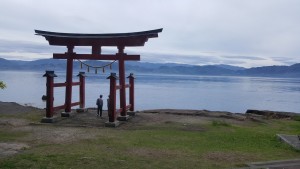
That afternoon, we listened to a lecture by a young farmer, which was interesting to hear from a new perspective on Japan. He addressed topics I hadn’t thought about before, like the social aspects of being a young farmer, including potential isolation. A group of Akita high school students then gave a presentation on their work testing methods of neutralization to address the acidity problem of Lake Tazawa. We then had a discussion about incorporating practical activities of primary industries into education, which pointed out some differences in American and Japanese education. While we said these classes could be made elective in America, Japanese students said their education is perhaps stricter in what you have to take, so introducing a class would essentially make it mandatory. Additionally, Japanese perceptions of farmers include strong, negative images of dirty and hard labor, which I thought weren’t as strong in the U.S, but might vary between regions. It was interesting to discuss with the KIP students and Akita high school and university students to hear different perspectives on education and industry.
Sunday morning the proprietor of the ryokan talked to us about tourism in Akita, followed by a discussion with KIP/Akita students. It made me think about how to actually attract people into an area for tourism, which I hadn’t thought about much before. How do we decide where to travel? It probably depends on reputation, like some form of positive feedback loop where more people go, so more people hear about it, even more people go, and so on. A member of our discussion group brought up an interesting point, that locations in the U.S. can attract people by being unique or advertising a special culture, but much of rural Japan is similar to other parts of rural Japan, so it’s harder to publicize being particularly different, relating back to cultural homogeneity.
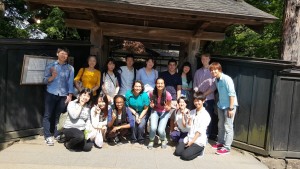
We traveled to Kakunodate that afternoon before we left, where we saw traditional samurai houses and architecture. I was somewhat disappointed there weren’t any cherry blossoms left; I didn’t think we had gone so long after the season that the trees would be completely green, with not a single blossom. (The trees were still beautiful of themselves though). In one of the samurai houses, there were several dolls and crafted outfits, which one of the KIP students said his family still uses to celebrate girls’ day and boys’ day. The dolls are used year to year, even generation to generation, but the kids and family make new outfits for them each year. I respected that something that was done so long ago, during the period of the samurai, is still used by Japanese families today. As far as the architecture, I enjoyed the wood carvings along the top of walls that project shapes of light onto the walls, and with candlelight would appear moving and alive. We walked around the town and met a very friendly street vendor who gave us many samples and told us about her son and his musical career. I ended the Akita trip by trying sakura ice cream at one of the sweets shops, and I think it became my new favorite flavor.
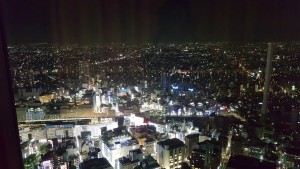
Back in Tokyo, we had an outing to the National Museum of Nature and Science. Although it seems stupid in retrospect, I hadn’t really thought about going to a museum in Japan and everything being in written in Japanese. It was still interesting to look at objects and pick out a few words, including the katakana for carbon nanotubes! In the same museum district, we visited an art museum. It was interesting to note how the forms of art varied from Western artifacts, as Packard-san had told us that ancient Japanese art had to have function as well as beauty, such as kimonos, sliding doors, and pottery. There was also a hall of beautiful traditional Japanese drawings that I enjoyed. That area of the museum district and Ueno Park was beautiful to just walk around and sit. Thursday afternoon, we had an outing to experience taiko drumming, which was a lot of fun. Taiko was an interesting mix of ancient and modern, as explained by our teacher.
Tuesday evening we also had a discussion with the KIP students on artificial intelligence. It provoked me to think about what makes us human and if there really is any part of us that could not be simulated in the far future. Are humans really unpredictable, or can our behavior be predicted by data and decision matrices?
My second week of language classes went well. I felt like I was starting to get more of a hang of the language. For example, I can pick up more words when I hear people speak in Japanese in restaurants or on the street. I was excited to expand my vocabulary by learning more adjectives and verbs, along with more diverse grammar structures.
Question of the Week
A question I have about Japanese culture is why do places close early? I wonder if people tend to get more sleep in general, or do people just stay at home for longer before bed? Is this anything to do with getting dark early/bright early, or is it more an issue of safety?
- This depends a great deal on which neighborhood you are in. In Azabu-Juban, where you stay during the orientation program, it is a more residential area with lots of small, family owned shops and restaurants so many things do close quite early. But there are also lots of restaurants and bars nearby that stay open late and if you walk down Roppongi Dori or head over to Shinjuku or Harajuku many things will be open very late. Each neighborhood in Tokyo has its own culture and daily rhythm with some being busy well into the night and others getting quieter and quieter as the evening goes on. Most museums, post-offices, government offices, and shrines do close early though, at about 5:00 PM and this is similar to what happens in the U.S. too.
Introduction to Science & Engineering Seminar
The first lecture by Dr. Stanton, from the University of Florida, helped me to further understand quantum mechanics and reinforce the material introduced by previous lectures. One of these clarifications was that phonons are quantized sound, represented also by lattice vibrations. The lecture was helpful for band theory of crystalline solids and associated forbidden energies and allowed energies, and how these diagrams translate to insulator, conductor, and semiconductor materials. I have a better understanding of E vs. k diagrams, and how this translates to direct/indirect and optically active/inactive materials. Quantum wells limit electron freedom, by limiting energies and lead to quantum confinement. I also gained further understanding of photoelectric effect and photovoltaics, specifically absorbing photons adds energy but no momentum, which leads to vertical movement in k-space diagram. These free carriers create photocurrent. Doping semiconductors creates either p-type (less electrons) or n-type (more electrons), which can then make a p-n junction. However, I am still not certain of what reverse bias means. Finally, it was interesting to hear how solar energy relates to band gaps and absorption of energy in solar cells.
The second half of lecture from Otsuji-sensei from Tohoku University was useful to learn more about Terahertz spectroscopy. It was interesting to learn about applications for THz imaging. It was helpful to get more information about the structure of graphene: sp2 bonded carbon atoms with 4 valence electrons but only 3 bonds, so 1 electron is free to move as a carrier with high mobility. It was also helpful to explain Raman spectroscopy more, which involves exposing a sample to electromagnetic radiation at one frequency, then identifying the vibrational frequency of phonons as the frequency that is absorbed, determined by using conservation of energy and the frequency that exits the sample. Finally, the lecture was useful to explain the principles of lasers, including pumping, population inversion, spontaneous emission, and stimulated emission. It was interesting and mind-bending to learn about gain and negative conductivity.
Ishioka-sensei’s lecture on Wednesday, from NIMS, was interesting for learning about women in science, especially in Japan. I did not expect there to be such a gap between genders, especially in the graphs comparing different countries, where Japan was among only a few countries where women lagged behind men in education. Japan seems so advanced, but to an American woman, these statistics seem to be the opposite. Ishioka-sensei’s lecture was also interesting to learn about spectroscopy, especially in understanding how the Pump & Probe method works.
The second half of the lecture by Dr. Stanton was also helpful in understanding spectroscopy. The different scattering mechanisms are due to phonons, impurities, carrier-carrier interactions, and recombination. Dr. Stanton also helped to understand spectroscopy with the analogy of stop action film, in that you must collect data at the time scale of the event in order to understand what’s happening. The femto fun facts were interesting but almost disconcerting, such as the geometric mean between 10 fs and the age of the universe is 1 minute. I was introduced to the types of lasers (CW and pulse). The lecture clarified pump & probe method more in that it shocks carriers out of equilibrium, and probes as a function of time to “see” how they settle back to equilibrium. Finally, the lecture was helpful in understanding coherent phonons, which are actually combinations of constructive superposition of phonons.
Week 03: Noticing Similarities, Noticing Differences
Reflection on Public Transportation:
It was interesting to reflect on Japanese culture through their methods using public transportation. Some rules that generally everyone follows include standing on the left side of the escalator to allow others to walk on the right, and not usually eating or drinking. However, I think people tend to follow these rules less strictly when it’s less busy or later at night. Any time of the day, almost everyone is on their phone, browsing and/or listening to music. A few other people sleep, and another few might be reading. It’s usually impressively quiet; people don’t usually talk, eat, or drink. As far as politeness, everyone usually says/whispers sumimasen if they accidentally bump into someone, although people seem to be more comfortable with being in closer proximity with each other than in the U.S. For the most part, everyone keeps to themselves, even when traveling with other people.
I don’t take public transportation too frequently in the U.S, usually just when traveling to cities with more developed transit systems. However, it does seem that people don’t really follow “rules” of where to stand or walk in the U.S. People are definitely louder, and act in a much wider variety of ways; you’re more likely to see “unusual” behavior. U.S. public transportation is definitely not as safe as Japan’s; here, very young school children are able to take the subway by themselves. In the U.S, it’s sometimes not advisable for women of any age to travel alone at night.
Some of the “rules” are cultural, while others seem more practical. For example, staying quiet is probably cultural, so as to be considerate and not disturb anyone else. The organized walking and standing is more practical in the rule itself, but cultural in the sense that people actually follow it. I think this shows an interesting merging of wa and kata in that people follow the established methods (kata) in order to allow the system of public transportation to run smoothly for the whole group (wa). Also related to group harmony, I think the relative safety of public transit is cultural in that people aren’t looking out as much for themselves, so they’re less likely to commit a crime against another person.
Week Three Overview:
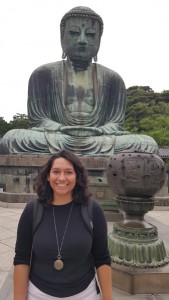
Last Saturday, we took a day trip to Kamakura with some of the KIP students. It was interesting that such a relatively short trip could take us to a place that was quite different from inner Tokyo. Kamakura was fun and very beautiful, with many hills and trees. We saw Engakuji Temple and Hachimangu shrine. My favorite place in these areas was a garden at the first site with many (very old) juniper trees; I loved the way the bark twisted in a fantastical and ancient way. We tried a relaxation activity to clear the mind, kneeling on mats, closing our eyes, and staying quiet. Not only this was peaceful, but so was the experience of walking around the carefully-kept grounds. In the town, we walked along the popular shopping street of Komachi Dori, which was an experience I had looked forward to with all of the vendors, shops, and boutiques. One of the shops was quite liberal with their samples, which were different fruit flavors of cold, honey-sweetened water—one of the most delicious forms of water I think in existence. We then traveled to nearby Enoshima Island, which definitely had a different feel from what I had seen so far of Japan—beachy and relaxed. Finally, we went to see Daibutsu, which was so large that it almost looked like a cardboard cutout.
For our first culture seminar of the week, Shimizu-sensei of Rice University, who talked to us about the history of U.S.-Japan relations through the lens of baseball. It was an interesting and captivating way of looking at history; baseball had more to deal with politics and my classic idea of history than I had thought. The historical use of baseball to influence politics made me think about propaganda and how the information we are given can be used to suit agendas.
Our next lecture was given by Dr. Lyons, the head of the NSF Tokyo office, over scientific diplomacy. This was also an interesting way of looking at diplomacy that I had not thought about before. I especially hadn’t thought about myself as an “unintentional” diplomat. It was inspiring to think about how we as science students can make a difference in bringing countries together.
Finally, Packard-san gave us a concluding talk the Friday before we left that included discussion of the religious influences in Japan. It was interesting to hear that although most Japanese people wouldn’t consider themselves religious, underlying spiritual ideas are realized through ritual actions in ceremonies, holidays, and even everyday life. It was also informative to hear how Shinto and Buddhism work together to contribute to the many ceremonies and festivals that the Japanese observe. Packard-san also reviewed important ideas in Japanese culture that would help us once we moved to our labs. These included aisatsu (greeting), wa (harmony), and group consciousness. That night, we had our final scheduled orientation activity, a discussion with the KIP students about science and bioethics. We covered some interesting ideas, specifically the human genome and a national database of genetic information. It was interesting to see the different levels of trust that Americans and Japanese had in their respective governments.
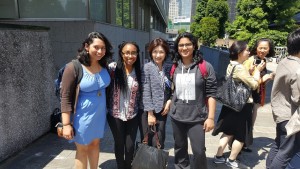
I enjoyed my last week of Japanese classes, learning more grammar structures and being able to make comparisons and nominalize verbs. We also spent time writing and practicing our speeches for the last day. However, it was sad to part with our senseis at the end of the three weeks. Although we had some of our teachers for only a couple of classes, we still learned a lot from them and it was bittersweet to conclude the language program.
Question of the Week
My question for this week is how are so many women able to wear heels, while living in Tokyo involves a good amount of walking?
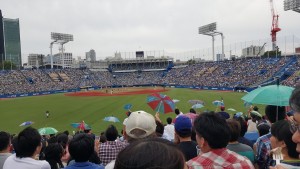
Introduction to Science & Engineering Overview
Dr. Bird’s first lecture was helpful to gain further information on semiconductor bandgap engineering. It was interesting to hear more detail on heterostructures and their applications. Specifically, his lecture clarified an important connection I had missed: that atoms’ discrete energy levels are the equivalent of solids’ wider gaps and bands. Additionally, his lecture helped to further explain electron/hole behavior and p-n junctions, among other ideas.
Aoki-sensei’s lecture was helpful to learn about the different types of microscopy, especially because we will be using various microscopy methods in our labs. It was helpful to understand the concepts of how these scanning probe and scanning gate microscopes work. It was interesting to hear how one can use the tip of scanning tunneling microscopes to manipulate atoms using attractive/repulsive force when moving closer/farther. We also learned about atomic force microscopy which uses a cantilever and laser, non-contact AFM, magnetic force microscopy, and electrostatic force microscopy. It was helpful to see the example of multiple microscopy methods used in conjunction to gain further information (such as comparing AFM, EFM, and SGM).
Dr. Bird’s second lecture covered graphene and the semiconductor industry. It was helpful to reinforce the content about the transistor revolution, and how miniaturization of transistors led to an increase of number of transistors per chip and therefore increased processing power. Because miniaturization is reaching a practical limit, a new philosophy is now needed. This requires a new paradigm, including finding new materials to replace silicon, such as graphene. The many excellent properties of graphene are due to photon-like (instead of normal electron-like) energy bands. The second part of his talk was useful for accurate information of what working in a lab in Japan would be like. It was useful to hear about this topic from someone who was in a similar situation to ours.
Final research questions
Although I believe I have a basic understanding of the concept of Raman spectroscopy, I am not entirely sure of how to interpret the resulting graphs (such as G/D ratio), especially how these relate to gathering information on carbon nanotubes, such as diameter. Finally, I wondered how exactly increasing CVD temperature changes the morphology of carbon nanotubes (such as causing vertical alignment)?
Return to Top
Week 04: First Week at Research Lab
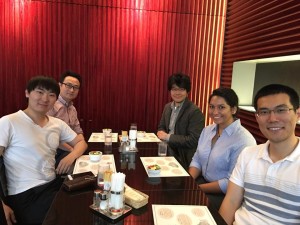
My first day in the Maruyama-Chiashi Lab at the University of Tokyo was definitely exciting overall, maybe a bit overwhelming. I met a lot of people, so there are a lot of names to keep track of, which is hard for me when they’re unfamiliar (I’ll admit to periodically checking the lab website’s photograph list of members). When I first arrived, Maruyama-sensei gave me a brief overview of what the lab was working on, and spoke generally about what my project would be. While there weren’t really any lab-wide special activities to welcome me into the lab specifically, during a seminar given by a visiting recently graduated doctoral student (last year’s NanoJapan student’s mentor actually), Maruyama-sensei introduced me to the students who were there. The first official lab meeting was on Wednesday, so I gave a slightly longer self-introduction then and passed out my cookies from Texas, which people seemed to like (yay!). Hopefully it wasn’t just in the polite Japanese way—at least, they took seconds. Afterwards, I went to lunch with Maruyama-sensei, and assistant professor Rong-sensei, the visiting Dr. Cui, and a post-doc, which was beneficial to speak with key lab members. After that, I kind of just sat at a temporary desk and read papers on my laptop, but later that afternoon, Rong-sensei introduced me to my mentors and gave me a project in more detail.
My mentors for the summer are Qian-san, a Chinese second-year master’s student, and Clement, a French second-year Ph.D. candidate. Qian-san is working on similar project matter, so we will be working together throughout most of the summer. Clement works more on graphene than SWNTs, but he will help me more later this summer once I need to characterize samples, though he is also learning to sputter alongside me and still shows me some things now. Qian-san is very knowledgeable on using the machines and methods, although I am worried because he can sometimes go through processes quickly. However, he is very busy outside of training me, so I don’t want to trouble him too much, although he is patient while I learn.
Interaction with other people in the lab is somewhat limited. There are two rooms, a larger one with the master’s students, some doctoral students, and the assistant professors, and a smaller one with some post-docs and other doctoral students. My desk is in the second room, where people tend to be quite focused on their work. The lab members are nice though, and helpful. I had lunch with a Korean master’s student one afternoon, and some lab members offered another time but we had the equipment reserved then.
The lab is pretty international, so a good number of people speak English. The lab meeting was conducted partly in Japanese, and partly in English. There are a good number of Chinese students, so they tend to speak English unless speaking Chinese to each other. While a good number do speak English, it does seem that there are some who speak majority Japanese without much English. Some signs and computer systems are in Japanese, so I can’t really read those, but a lot are also in English, especially around the equipment. Our lab secretary has good English, but I have run into a few difficulties communicating clearly with her. I think I should be fine for the most part speaking with lab members, and if not, I think there is usually at least someone around who could help.
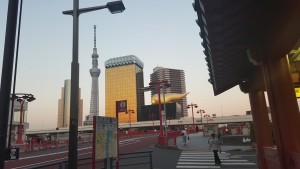
My housing is quite nice. It is located conveniently near Asakusa, so there are many shops and restaurants that are a quick walk away. It is shared housing, which is kind of interesting. My housemates are very international, from France, Russia, Korea, China, Germany, Vietnam, and Ukraine. I interacted with them more as the week went on, from a quiet good morning/good night to actual conversations. One night, two of my housemates with better Japanese skills gave myself and another girl a casual lesson in Japanese from a magazine. It is interesting how these people coming from a wide variety of backgrounds will switch between many different languages, such as Japanese, English, French, and Chinese, all in one conversation. As for my room itself, it has a lot of windows, so I’m a happy camper. The room is definitely bigger than Sanuki’s, and more spacious than I expected. We have a shared kitchen and bathroom, and all of the facilities are well-maintained. To get to the lab, I usually walk about a minute just down the street to Kuramae station, take three stops down the Oedo line to Hongo-sanchome, then walk about 15-20 minutes to get to the lab building.
I have begun work with my research project and training with the equipment. Maruyama-sensei talked to me on the first day and gave a broad orientation of the project, which was to create better quality SWNT film, specifically for other members of the lab to use in making solar cells (ideally better quality than the company they usually order from). I then later talked with an assistant professor, Rong-sensei, who narrowed the scope of the project. Initially, I will be trying a method to make SWNT film with greater transmittance for solar cells. He said it shouldn’t take too long though, maybe even a couple of weeks, so then I will continue optimizing SWNT for other characteristics, such as for greater length or conductivity.
Assessment of Orientation Program and Language Classes
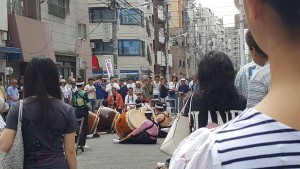
Orientation was useful, especially because arriving in a new country is less frightening when you’re with 13 friends and multiple advisors. It was also beneficial to be given both cultural and scientific lectures, to ease in to both aspects of the program. The outings were very cool, especially because we might not have done them otherwise, particularly Akita and taiko. While it was a pretty packed schedule, which could be tiring at times (with reports, reading papers, sight-seeing, etc.), I think it was worth it to fit it all in.
The most helpful thing I learned about Japan was how the politeness culture affects everyday interactions. I wouldn’t have known otherwise to be suspicious of any “yes” that isn’t overly enthusiastic, or not to say no outright. About myself, I learned I am even more of a visual learner than I had thought. If I learn Japanese words or phrases only orally, they practically fly out of my head after a minute or two, but I can learn them much easier if I can see them or write them down. I knew I was mainly a visual learner, but I didn’t think I was that little of an oral learner!
Although our classes were very helpful in learning useful, working Japanese, I’m still not very confident in my Japanese skills. I’m in one of those cycles where I don’t use my Japanese because I don’t trust it, but then I don’t practice so I don’t get better, and so on. However, at the first lab meeting, I introduced myself in English first and then repeated it in Japanese, and I noticed that people kind of perked up or gave a better response when I did, so I do want to try jumping in and using it more. One goal is to learn enough kanji that I don’t automatically dismiss something written in Japanese because I have 0% clue what it says; it’d be nice to get up to a ~25% clue level of what it says.
Question of the Week
This week’s question is how are there so many vending machines if people don’t drink in public?
Research Project Update
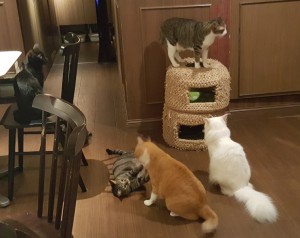
My research project is generally to synthesize better quality SWNT film. The first characteristic we will try optimizing is increasing transmittance. We will try a method that Rong-sensei had conceptualized but had not had time to try yet. This method involves sputtering copper onto a Si/SiO2 substrate, then annealing so its morphology is clumped into “islands.” We will then sputter cobalt over this film, because Co is the catalyst we will use to grow SWNT. Then we will remove the Cu using FeCl3 etching, so only the pattern of Co (with empty space where the Cu particles were) remains. This remaining Co/Si/SiO2 material will be the substrate we will use to grow the SWNT. Ideally, the connections of the film overall will remain so conductivity is not affected, but the holes where the Cu atoms originally were will allow more light to penetrate, increasing transmittance. Additionally, we hope the Co is not also removed with the Cu etching.
So far, we have annealed Cu film thicknesses of 10 nm, 20 nm, and 30 nm at 500C, 550C, 600C, and 650C for 10 min and observed the results under SEM. At 500C, only the 10 nm film produced island morphology. However, at 550C, the 20 nm film also produced islands, while 30 nm began to show some separation in the Cu film. At 600C, all three showed island morphology, though to varying degrees. While 600C and 650C produced island morphology, we worry that the Cu might have clumped too much, especially in thinner films, which would allow greater remaining space for the catalyst. Nonetheless, we will now proceed to the next step of sputtering Co onto the Cu/Si/SiO2 substrates.
For materials synthesis, I will be using sputtering and chemical vapor deposition (CVD) methods and their associated machines as equipment. I will characterize with the scanning electron microscope (SEM) at least for now, although I will probably also characterize using other techniques in the later part of the summer (such as Raman and measurements for sheet resistance and transmittance).At this point, I have been trained in how to use the sputtering machine, SEM, and the CVD machine, but only for its furnace to anneal (not using EtOH to grow CNT). As for materials, I will be using Si/SiO2 substrates, Co and Cu targets for sputtering, FeCl3 for Cu etching, and then EtOH for CVD synthesis of SWNT. However, these are the methods and materials for the first part of the project (transmittance), and I might need to learn other techniques as the summer goes on.
I don’t really have a clear timeline at this point in the project. However, Rong-sensei thinks I might be able to finish this first transmittance project within a few weeks. (Although there is a learning curve with the machinery and handling samples—I’m pretty slow right now.) After that, I would move onto optimizing other characteristics of SWNT, while also incorporating this method of increasing transmittance. These characteristics might include SWNT length, conductivity, or uniformity.
Week 05: Critical Incident Analysis – Life in Japan
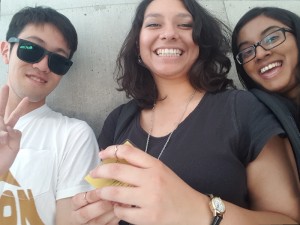
I experienced a “cross-cultural communication” situation one night while Chandni and I were trying to print out my invitation at a 7/11 kombini. (My invitation to the Japanese Fulbright Reception where we were able to meet Caroline Kennedy!). However, it turns out that the printing machine is only available in English for the options of making copies and printing photos on photo paper, neither of which would work for me. I then decided to try figuring it out in Japanese, using the little pictures on the side, hopefully general systems of user interfaces, and maybe some katakana (puriinto). So at a certain point, we’ve been able to find the printing option, pull up my USB drive, and choose the right file, but I am having difficulty figuring out how to get it to actually print.
At this time, two Japanese girls behind us come up and kind of just take the USB and move us out of the way, which was unexpected. Although then they explained that they’d help us but to let another person go first. In the meantime, we all just awkwardly stand there nodding to each other, until the other person finishes and they begin to help us. There is a slight language barrier although they speak some English, so we were able to get across that I didn’t need to copy (mainly by saying I don’t have an already existing paper) but that I need to print from a USB (by pointing to the flash drive). However, they don’t completely know how to operate the machine either. The girls call over one of the 7/11 cashiers, who tries figuring it out. Although, surprisingly enough, he doesn’t know how to work the machine either, so he calls over his other fellow cashier.
By this time, we have enough people around the printing machine to have a nice dinner party. With the help of the two Japanese girls, the cashiers understood that I needed to print a PDF from a USB. Thankfully, the second cashier knows how to do this, and she pushes buttons…until we are looking at the screen that I had originally left off on, funnily enough. She then asked the Japanese girls if they could do it from there, and they said yes, so we thanked the cashiers profusely and they returned to their jobs. The two Japanese girls then proceeded to tell me that I needed to just put in the money and press print. (So turns out, I just needed to put in a 10 yen coin and the big print button would have appeared.)
Although, the thing that really cracked me up is that we weren’t sure what size to print, and the Japanese girls didn’t know either, so we all just decided to go with the largest size. But it turns out that the largest size is really actually quite large. But I was definitely not going to take up any more time, so I just thanked everyone profusely and walked out with my very, very large invitation.
(To finish out the story, I went to a Family Mart down the road to see if they had a printer—and they did. In English.)
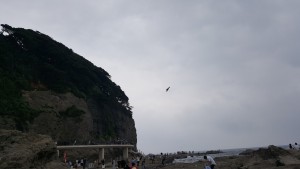
In this situation, my good intentions were that I wanted to print what I needed without bothering anyone. I wanted to figure something out in Japanese, without having to disturb a Japanese speaker to help. However, my motivation to do it individually was not aligned with the group idea of solving it together. On the other hand, the positive reasons behind the Japanese girls’ actions were to allow the other customer to use the machine but also to help me. The group as a whole wanted to see me through, no matter how many people it took. This points toward the group attitude of working together to promote harmony.
Next time, I’d definitely keep checking to make sure no one was behind me throughout the entire time I’m trying to figure something out, so I could let them go first and then continue on. Also, in the situation where the girls are helping me, I probably would try pointing to the things I had done, and then asking if those would get me to the right place, to save us both time. However, I did learn a number of things from this experience. I learned how to accept the help, even if it makes me slightly uncomfortable to have the entire staff of a 7/11 and half of its current customers helping me print out a PDF file. I also conveniently learned how to print in Japanese, and even which paper size is the normal one (yep, A4). Finally, I learned how the group can work together to make sure one person succeeds.
Question of the Week
Why are there emergency buttons in the bathrooms? Are these for bathroom-related emergencies, or in the case of an unrelated emergency, you know where to find an emergency button?
- Yes, travelers in Japan are often confused by all the buttons in the bathroom and a bit unsure of which button is actually the one to push to flush the toilet. While bathroom related emergencies may be rare, in a rapidly aging society the emergency call buttons/cords are there for the elderly or disabled so they can call for assistance if needed. In the U.S. you often find these emergency buttons or pull cords in hospitals or nursing homes for similar reasons. However, the key is to be sure not to accidentally push the emergency button in a public restroom in Japan or you might end up in a bit of an awkward discussion with someone very concerned that something may not be okay. But if it does happen, no worries, as its not than uncommon for tourists to hit the wrong button and usually ends up in good-natured laughter once they realize that you are okay.
Research Project Update
This week we continued the process we had outlined in the beginning, including moving on to sputtering Co, etching with FeCl3, and growing CNT with CVD. However, we did run into some difficulty with our original idea that prevented significant growth of carbon nanotubes that I will discuss later. (I also gave my first research update at the lab meeting last week, so I attached those slides in case you would like to see them).
I used GIMP to approximately analyze the percentage of Cu area on the SEM images of the annealed Cu “islands.” These percentages were not highly accurate because they are based on dividing the image by value, and some areas of Si/SiO2 were the same shade as Cu in the images and thus not clearly separable. As a result, I used a range of values from a selection that included most of the Cu and therefore some Si, to one that included less Si but also then less Cu. Not all of the images could be processed in this manner because some (20nm/500C, 30nm/500C, 30nm/550C) didn’t anneal into the island morphology. The values ranged at the most to be 36% (10nm/500C) and at the least 15% (30nm/650C); all values are in the table below. Because all of these values are lower than Xiang-sensei had thought ideal (80-90% Cu area), we might consider varying the other parameters of Cu annealing, such as annealing time or rate of heating, rather than just temperature. We might also try more temperatures between those that did not clump and the first samples to clump, such as between 500C and 550C for the 20nm film.
In the meantime, we moved forward with the current annealed Cu on Si/SiO2 samples, sputtering 0.3 nm Co onto all twelve of them. It kind of amuses me that sputtering each sample is an hour-long process, but only 6 seconds of that is actual deposition of cobalt onto the substrate.
We then began FeCl3 etching for some of these samples: the 10nm, 20nm, and 30nm annealed at 650C set. We decided to start with the 650C (with lowest Cu area percentages) in case the process did not work accordingly, which probably turned out to be a good choice. The FeCl3 process we used involves: 1)-10 minutes in 1M FeCl3 solution, 2)-rinsing with distilled water, 3)-30 minutes sonication in distilled water, 4)-5 minutes sonication in acetone, 5)-5 minutes sonication in IPA, 6)-30 minutes soaking in distilled water, 7)-blowing with N2 to dry, and 8)-5 minutes baking at 400C.
We then performed CVD on these three etched samples at 800C for 5 minutes using ethanol. Afterwards, we observed these samples using SEM. Unfortunately, we found very scarce CNTs that were scattered along the edges. We are thinking that the FeCl3 also reacted with the Co, instead of just the Cu, and removing the catalyst resulted in virtually no CNT growth. (Looking at the activity series, it would make sense that Co is more readily oxidized than Cu, but I haven’t been able to find information on the reaction of Co with FeCl3 specifically.) We will now have to re-evaluate and make some change to the process. We will speak to Xiang-sensei about our next steps, whether changing the Cu film to another material, choosing a different catalyst, or possibly finding an etchant that would remove Cu but not Co.
Return to Top
Week 06: Preparation for Mid-Program Meeting
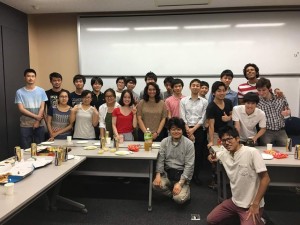
I think my biggest personal accomplishment so far (besides not yet losing my umbrella) would be getting up the courage to go to new restaurants alone, especially if they only speak Japanese. At the beginning, I was too scared to go to restaurants or shops that didn’t show some indication of an English speaker or menu, but now I’m more likely to just try a random place. Several times I’ve been able to go eat and conduct the business only in Japanese—although very, very basic Japanese. Of course, there is often some pointing and gesturing. I definitely hadn’t realized before coming here just how much gesturing can get across. It’s also surprising to me how much you can figure out just by context clues. However, I have discovered that numbered menus really are a blessing—even if I can’t read the kanji, I can say the number next to it. Vending machines are also great, because it’s fun to just go for it if I have no idea what it’s saying.
I think this little triumph has to do with a personal development of just accepting a situation where I don’t know what’s going on. In America, I think I have a tendency to play it safe and do things or go places where I have an idea of what is happening and what to expect. I think it’s personal progress to be willing to walk blindly into circumstances where I’m somewhat clueless and have to rely on others and myself to figure it out. It’s kind of like a little part in taking on my fear of the unknown.
I would say my biggest personal challenge right now is getting up the nerve to speak to my lab mates. I am a naturally shy person, even back home with people I know I’d share things in common with. I think the fact that people here come from such different backgrounds just augments my shyness, because I don’t want to offend or overwhelm them. Although I think the biggest reason I’m reluctant to approach people is that everyone is very busy, and I just never want to bother anyone. I’m worried that they’ll feel obligated to be polite and continue interacting with me, even if they have work they need to get done. Currently, I’ll say hello/konnichiwa to people, but it rarely progresses past a greeting and a nod. I think a good challenge for me would be to try to approach other lab members and start conversations, instead of only reciprocating if they happen to say something to me. Although they just threw me a welcome party yesterday (in conjunction with another member’s farewell), so maybe this’ll be a good catalyst to get me closer with my lab mates.
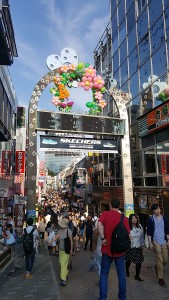
I think this problem might also point towards another personal challenge. I generally have a tendency to over-think things, which has most definitely gotten worse since I’ve been in Japan. Although it can be good to be thoughtful and try being rational before making decisions, there are so many more aspects I end up considering within the context of Japanese culture, especially things that I’m unsure about, that I wind up wasting time instead of just acting.
Although my research project looked somewhat doubtful at the beginning of last week, it has since been looking more hopeful. At the beginning of last week, it was looking like my project wasn’t going to work out, and I might have to start a different one. However, during the week, we tried two other different variations on the fabrication process, and the results were much better. By the weekend when I sent Maruyama-sensei my mid-program meeting presentation, he mentioned the possibility of even making a paper out of the project. However, I still don’t have a clear timeline for the project. So far, we’ve been going along idea by idea, to see what will work and what won’t. We will have to do characterization, but we need to improve the process so the films are of sufficient quality to transfer.
Question of the Week
I’ve been wondering about the political dissenters who park vans in busy areas and speak loudly over megaphones. Firstly, I was just kind of wondering what they are protesting. However, it also seems that most Japanese people very deliberately avoid eye contact, and when I’m with Japanese people, they expressly say not to interact and just keep walking—so I was wondering if they actually convert members of the public to their ideas or do it more to stir the pot?
- Two things are going on here possibly. One, it is election season in Japan so you may be hearing politicians campaigning using megaphones on campaign vans. The other option is that these are sound vans which are often used by right-wing groups in Japan and can be heard throughout the year in Japan. While the likelihood of protests turning violent in Japan is low, students traveling abroad should always avoid any political protests or large groups/parades of people as it can often be unclear what these are about and you may get caught up in something that is not quite what you expected or believed it to be.
Research Project Update
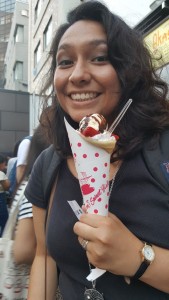
The project this week has been somewhat of a rollercoaster. This time last week, there was a real possibility that I would have to switch projects, but by the end of the week, the results started to show some promise. Originally, the idea had been to etch the Cu and then grow SWNT, but this resulted in no SWNT growth (likely because the Co also reacted with FeCl3). Last week, we tried two other processes to avoid this problem and preserve the Co for CVD. The first was oxidizing before etching then CVD, and the second was first growing SWNT with CVD, then etching the Cu.
For the oxidation process, we baked the sample (30nm Cu/600C annealed) at 400C in air for 5 minutes. Observing it in the SEM showed that the texture of the Cu had changed, with bumps along the islands instead of smoothness as before. We then submerged the oxidized sample in FeCl3 for 10 minutes to etch it, then rinsed with three water baths. We began sonication in water, but it appeared that the middle of the film began to come off, so we stopped and blew it with N2 to dry. We again looked at the sample in the SEM and saw that the Cu was not significantly etched; rather, it looked as if the islands had just broken apart a bit. So while the oxidation protected the Co from being etched, it also prevented significant removal of the Cu. Nevertheless, we then performed CVD with standard parameters (450 sccm EtOH at 800C 5 minutes). We observed in the SEM and saw SWNT growth. However, there were still Cu islands remaining. Additionally, the SWNT film was not as dense as what the lab usually produces, so the Co might have been affected by some point in the process. Therefore, while this method was more successful than the first, it still was not entirely suitable.
During the lab meeting where I presented the previous results, Maruyama-sensei suggested to grow the SWNT using the substrates as-is, with the annealed Cu and Co films, and do FeCl3 etching afterward because the SWNT would not be significantly affected. We tried this method with the 20nm Cu/600C annealed sample. We did CVD with normal parameters (450 sccm EtOH at 800C 5 minutes), including a reference Co/Mo dip-coated sample. This was in case of low SWNT yield, so we could determine whether it was our process or the CVD that was affecting growth, depending on whether the reference Co/Mo sample yielded VA-SWNTs (indicated by a black color). After CVD, we examined the sample with SEM and did observe significant SWNT growth, although less dense towards the edges of the substrate. We then proceeded with the FeCl3 etching, using the same process as before (10 minutes etching and three water baths). To dry, we heated the sample on a hot plate at 100C for an hour, then left to further air dry overnight. The next day, we observed in the SEM and saw promising results. Certain areas of the film produced the desired morphology, with pockets of low-density SWNT surrounded by a network of high-density SWNT. However, the film was significantly lacking in uniformity. There seemed to be different sections or regions within the film: our desired pocket film, a similar film of different texture, a transition region, and another barren region with what looks like Cu imprints. While the first two regions match our desired material, we need to continue working to produce more consistent, uniform results. This is especially important because we need to transfer the film before we can characterize it, and Qian said this film is too thin and non-uniform for successful transfer.
We will now try this method again with different samples. However, we will slightly modify the etching process. The last film was significantly more uniform before etching than after, so we will first target this stage to improve the film. We will still do FeCl3 etching for 10 minutes and three water baths, but we will then anneal the sample at 175C for three hours instead of the previous drying method. When we achieve SWNT of acceptable quality, then we can begin characterization.
Return to Top
Week 07: Overview of Mid-Program Meeting & Research Host Lab Visit
Chandni and I traveled to the Kansai region on Saturday (a day earlier) to get to see some sights outside of Kyoto. Although we planned on going to Nara, we ended up just staying in Osaka and hanging out with Donald, Daniel, and Shweta, who had also come a little earlier. That afternoon, we walked through a huge and beautiful greenspace, the Expo City Park, and that night went to a driving range where we hit golf balls off a balcony (great stress relief). We didn’t really see the classic touristy Osaka things (although I did eat takoyaki and okonomiyaki), but it was a lot of fun to spend time with other Nakatanis.
It was a great reunion to see everyone back in Kyoto station. We then traveled to our hotel, the Kansai Seminar House, as Endo-san pointed out notable sights in Kyoto along the way. Once there, we had a de-briefing session where we talked about successes and setbacks in personal areas, research, and life in Japan. It was good to reflect on our experiences so far and hear how everyone else had been doing.
The next day we went to Kyoto University. In the morning, all of the Nakatani students gave presentations introducing our research projects. It was interesting to hear more about what everyone else was working on, especially because the projects were more diverse than I was expecting. Afterwards, we had a lunch party with students from Kyoto University, which was nice to be able to talk with the Japanese and Chinese students there. It was especially neat because some people had worked in Maruyama-sensei’s lab, including Yoshida-san (also a Tomodachi Program student) and Miyauchi-sensei, who had actually helped invent the ACCVD process I am using to synthesize carbon nanotubes. We then had lab tours for a variety of different labs, including a chemistry lab focused on metallic-organic compounds and a cell biology lab focused on RNA and neural networks. We then switched tour groups and saw a biology-based microscopy lab and Terahertz spectroscopy lab.
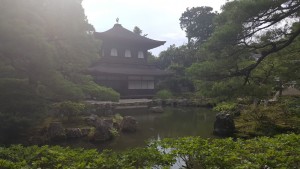
Before going back to the hotel, we went to see Ginkakuji, or the Silver Pavilion. It was probably my favorite site in Kyoto, because it was so beautiful and serene. The grounds were unbelievably well-kept and it felt almost mystical to walk among the all-encompassing greenery. Not to mention I just really liked their moss for some reason. I especially appreciated Packard-san’s explanation of Ginkakuji in relation to Kinkakuji (which we saw the next day), because while the gold pavilion was meant to intimidate and impress, the later silver pavilion was built as a peaceful place to welcome culture and intellectual gathering.
Once we returned to the hotel, we had a barbecue to celebrate the 4th of July. It was interesting to experience Independence Day outside of the country for the first time, especially considering how young America is in comparison to all of the history compiled in Japan. After dinner, I was led into the dining room, blindfolded, and spun around a bit, then opened my eyes to some surprise birthday cake! (Thank you, Sarah!) I was pretty lucky to celebrate my birthday with all of the Nakatani students together in one place.
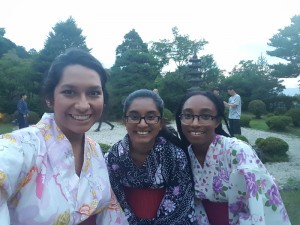
The next day was devoted to sight-seeing and cultural outings in Kyoto. The first stop was Kamigamo shrine, where a Shinto priest gave us the history of the temple and the story of how it began, as well as the meaning of different elements of the site as we walked through. However, we were given the special opportunity to even go into the inner part of the temple after a purification ceremony. Horikawa-san from the Nakatani Foundation had organized our Kyoto touring, and because his family has been established in the Kyoto area for so long (1500 years!), he had special ties with the temple and we were able to enter in.
We then traveled to a teahouse where we participated in sado, a tea ceremony. It was captivating to watch the ladies’ precise movements and ceremonious actions. After the tea ceremony, we visited Kinkakuji, the Gold Pavilion. It was quite impressive with the shining gold exterior. I particularly enjoyed Packard-san’s accompanying history info session, about how the layers of the pavilion represented different classes and the builder was of the second class, which is why only the top two layers are covered in gold, and the second layer is interpreted as squashing the bottom one down. Our final outing of the day was visiting the Gallery of Kyoto Traditional Arts & Crafts, where we watched artisans practicing their craft, including bamboo weaving, ceramics painting, and Buddhist statue carving. We finished the day with yukata and hanabi (fireworks) back at the hotel.
Our last day of the Mid-Program Meeting, we traveled to Kobe to tour the Sysmex Technopark. We were welcomed by Hisashi Ietsugu-san, Chairman and CEO of Sysmex, but also Executive Director of the Nakatani Foundation. During lunch, we got to try Kobe beef, which really was fantastic. For the afternoon, we toured the offices, labs, and parkspace around the Sysmex complex. The entire Sysmex experience was pretty impressive, from the buildings themselves (particularly the beautiful teahouse and koi pond), to everything they had prepared for tours (we even wore earpieces to hear the tour guide), to the consideration they put into design for impacting the working environment (such as a meditation room in the park and specific “collaboration spaces” in the offices). After Sysmex, we all left to go back to our labs.
As for the most impactful part of the mid-program meeting, I honestly think it was just getting back together with everyone after a month apart. I didn’t expect to be so grateful to be with everyone, just hanging out in the hotel, at meals, in the bus, wherever. But then it was funny to notice how just those four days brought us even closer together this time around. For example, before we left for our labs after orientation, the goodbyes weren’t really that big a deal, but this time around they were more drawn-out, with more hugs, and more miss you’s.
However, it was also unexpectedly nice that I actually really enjoyed presenting on my project. I think it was good to realize that even though I was nervous at first, I ended up enjoying talking about what I was doing and sharing the idea with others. It was refreshing to be reminded that I care about and get excited by my research.
I would say my biggest challenge during the trip was trying not to compare too much between myself and the other Nakatani students. In particular, I tended to compare how research was going, what life was like, and relationships with lab mates. I think it was hardest to just accept what everyone had for their own experiences, and not be uncomfortable by how mine didn’t always match theirs.
As far as something learned to help the rest of the summer, I think the most beneficial were tips for trying to integrate more into the lab life. In particular, I appreciated the advice to bond with other international students and ask how they tried getting into the social life of the lab. Additionally, I could try just inserting myself into conversations, even if that isn’t normally my style.
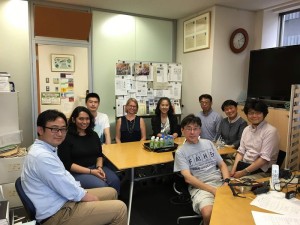
During the research host lab visit, it was nice to see everyone again (Sarah, Kono-sensei, Endo-san, Ogawa-san, and Packard-san), even if it had only been a couple of days. We sat in Maruyama-sensei’s office for a while and talked about the project and progress of the research (and other miscellaneous things). It was good to talk about my project, to explain what I’ve done so far and think through what I still need to do. After this, we went down to the lab so I could show the machines I regularly use. I was pretty surprised when Maruyama-sensei joined us even for this, because I had never actually seen him in the lab before. Kono-sensei mentioned that several labs at Rice are also using CVD to synthesize CNTs, so I will have to look into that for the future. Finally, we all went back up to join my lab in a party for the B4 students after their midterm interviews.
Research Project Update
We continued onto another sample (20nmCu/550C annealed) using the CVD then etching process. Instead of drying after etching like we did with the 20nmCu/600C sample, we annealed this sample for 3 hours at 175C instead. The resulting film was slightly more uniform with smaller regions of distinctly different (undesired) morphology. Additionally, the holes in this film were clearer, with less SWNTs growing across the pocket areas.
We also measured sheet resistance of the first sample of this process (20nmCu/550C) using the four-point probe method, which I learned from Clement. The measurement turned out to be quite high, about 44 kilo Ohms per square. We will have to reduce the resistance of the films, hopefully through making the SWNTs longer and more crystallized.
After this, we had a discussion between Qian, Xiang Rong sensei, and Maruyama-sensei about what we should do next. The general idea from speaking to the senseis was to focus on two objectives: pocket size mainly and SWNT quality film secondly. We need to work on increasing pocket size area so that we can guarantee a high percentage of transmittance just from the holes. Additionally, we need to increase the quality of the SWNT film so that we lower the sheet resistance. However, the two focuses are prioritized in this way because we can show the comparison of our processed films to unprocessed Co-catalyst films—ideally increased transmittance without significant drop in conductivity—even if both films have high resistance.
To increase pocket size, we might try using thinner Cu films at lower annealing temperatures to increase coverage, or perhaps much thicker Cu films for large-scale islands. We might also try other metals, particularly Au or Cr.
To improve quality, we will try incorporating another step into the process, oxidizing the Co film before CVD, which should help uniformity. Although this means the Cu islands will also be oxidized (as from the previous oxidation attempt which prevented successful etching), the Cu will now be reduced in the Ar/H2 reduction step of CVD, so it should be able to be etched. However, the first sample we tried this with (10nmCu/600C annealed) grew thin SWNT film. We checked the Co/Mo reference sample, which also did not turn black with SWNTs, so something could have gone wrong with that specific CVD run. It is possible that the CVD was affected by a few hours between pre-CVD and CVD, during which I had turned off the EtOH bath. We will try this oxidation/CVD/etching process again with another sample.
Week 08: Research in Japan vs. Research in the U.S.
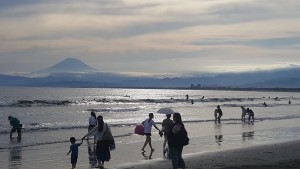
I work in a significantly international lab, where I probably interact more with non-Japanese students (especially Chinese) than Japanese students, although a majority of the lab members are still Japanese. In conversation, people almost always use honorifics when addressing a Japanese lab member. However, when addressing an international student, Japanese lab mates are more likely to use an honorific than a fellow international student would. It kind of surprises me when lab members use the lower “-kun,” because it catches me off guard to hear the hierarchy so explicitly stated, even when there’s only a year difference between the two people.
As for conflicts, it’s generally just somewhat awkward when people disagree—I feel like even more than in America, because people are trying to disagree politely, but I’m not really sure. However, I think disagreements usually just resolve in the way of the superior person. I do remember during a lab meeting, a (Chinese) master’s student didn’t agree with what Maruyama-sensei was saying, and ended up saying to him outright “no.” There was kind of an awkward silence (as opposed to the usual background whispering or rustling) before Maruyama-sensei replied, kind of chuckling in shock, “Don’t disagree with me.” Then the student realized that Maruyama-sensei was right and agreed to do what he had said.
Compared to the orientation preparation for our lab, I expected there to be more group identity within the lab. However, I do think it is because I work in such a large lab. There does seem to be group identity within research groups, such as the graphene group, or the FET transistors group, but overall as a unified lab there is less than I expected. As another small thing, I expected there to be more emphasis on aisatsu (greetings) in the lab. However, I think it is the norm to just walk in and out of rooms without saying anything.
I think Japanese and US academic research pretty much value the same things. Maybe Japan places more emphasis on hard work and America more emphasis on results, but I can’t really confirm because I haven’t worked in an American lab. While I definitely enjoy researching in Maruyama-sensei’s lab, I tend to think that I’d prefer working in an American lab. For one thing, Japanese lab members tend to work very, very hard. I don’t mind working hard for this summer, but I think I’d get tired of 12+ hour work days like some of my lab mates do on the daily. Also, I think I’d like an American lab that is more casual and relaxed about interactions between lab mates and professors. However, I do think I prefer how Japanese labs tend to be more socially close-knit, but again I can’t compare for sure.
Question of the Week
How prevalent have countercultures been throughout Japanese history, and has their prevalence been at all affected by Westernization?
Research Project Update
After returning from the mid-program meeting, I continued once more with one of the two remaining Cu samples (10nm/550C annealed). This process involved oxidizing the Co before SWNT growth, with the Cu still remaining. However, this again did not yield a satisfactory amount of SWNTs or density of SWNT film. Additionally, there seemed to be another film coating within the SWNTs; it is possible that it was evaporated and recondensed Cu partciles from the Co/Cu oxidation process. However, we still plan on FeCl3 etching these samples to be thorough.
After speaking with Xiang Rong sensei, we decided to move forward using Au instead of Cu to address certain problems we’ve been having. With Cu, the process is not as “clean” as originally/ideally conceived, because we are not able to etch the Cu before growth. This could be affecting growth of SWNT (as seen in low-density SWNT film growth). Additionally, the Cu shrinks again during the 800C reduction before CVD, nullifying the control available in pocket size by annealing the Cu at different temperatures or thicknesses. If we were able to etch the metal before growth, we would not have to worry about additional shrinking during CVD. Therefore, we are trying Au films instead. We can coat Co over the annealed Au islands, and because Au is not easily oxidized, we can protect the Co from reacting with the etchant (KI) by oxidizing first. Consequently, the Au will be removed, and the Co network on Si/SiO2 will be used as substrate for SWNT growth. Along this path, I have learned how to use the vacuum evaporator for Au deposition from a lab mate, Sakaguchi-san. I have deposited 10nm, 20nm, and 30nm Au films onto Si/SiO2 substrates. This coming week, I will continue with the process, including: annealing, Co deposition, oxidation, etching, and SWNT growth.
Week 09: Reflections on Japanese Language Learning
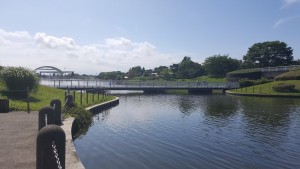
Our Japanese language teachers definitely did a wonderful job teaching us the Japanese we would need to successfully navigate day-to-day interactions, especially considering it was within three weeks. However, I think my Japanese skills unfortunately declined after the orientation’s language classes were over. Living in Tokyo, it’s pretty easy to scrape by without using too broad a vocabulary; I always end up using the same words over and over again. Beyond these simple words, the language ring widens much more after that. After the basics, there is a whole number of other words that are at the same difficulty level, so to speak, so the chances I’d know the specific words used are somewhat slim. I notice this especially in that even if I have learned how to say or ask something, the chances are that I don’t know the words they will use to respond.
There are many very small-scale linguistic mishaps that happen pretty frequently, but they usually aren’t too big a deal. I do remember one of these mishaps, which did resolve itself just fine, but perhaps was more of a challenge because of a more stressful context:
After one late night of working in the lab, I’m returning home past midnight and walk into the subway station. I’m a little worried because I’m not sure exactly when the last train is, the hallway seems pretty empty, and there’s a subway worker standing in front of the card gates saying something in Japanese on repeat. As I walk closer, I’m looking at him, and he’s looking at me, but I still can’t figure out what he’s saying (even though it has been repeated a good five times). But I’m really hoping he isn’t saying there are no more trains. As I come closer, I pull out my confused/worried/sorry face, and ask “Mo ichido, onegaishimasu.” So he says it again. And sixth time isn’t the charm. So then I play my “Sumimasen, yukkuri onegaishimasu.” And he says it again, slowly. But it turns out, the seventh and slow time is also not the charm. So I muster up my most regretful face and give in with an “Eigo de onegaishimasu.” But he returns with an equally sorry face that definitely means eigo de hanashimasen. So he is etto-ing around for a bit, but then points to my phone and says something about my eki, so I assume he’s asking where I’m going and say my station, Kuramae. After this, he just gives me an “O.K.” accompanied by a thumbs up, and gestures toward the gate. I thank him (albeit confusedly) and go through the gate, able to catch a train a few minutes later.
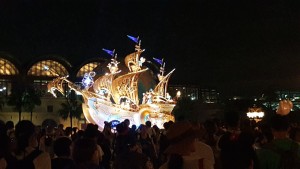
I still have little idea what he was trying to say (although I assume that because it was late, the train wasn’t finishing its entire route), but I’m glad I was able to make it home. I learned yet again that a lot of communication is kind of extraneous. I didn’t really need to know what was going on, or why there might be a problem; it was enough to just get an affirmative and go. I also learned (yet again) that Japanese people are incredibly helpful and will keep trying to help until the situation is settled.
While at the lab, I’m trying to learn kanji through a helpful app. I use it while waiting for machines or processes or during whatever downtime there is within experiments. Sometimes if I’m at my desk and don’t have any more desk work, I’ll pull out my old class notes and go through them again, though it can make me somewhat sad the amount I’ll have forgotten. Although I feel slightly creepy, I also tend to eavesdrop on other people’s Japanese conversations in lab or just walking around wherever. Sometimes I can get the gist of what they’re talking about, but I’m usually able to at least pick out a few words here and there.
Nevertheless, I still enjoy the language, and I do get pretty excited when I can understand something or successfully communicate with someone. I want to continue taking classes when I return to Rice because Japanese really is a beautiful language that I’ve enjoyed learning.
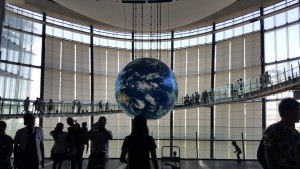
Research Project Update
This past week, I worked on trying the fabrication process again, but using Au instead of Cu for the metal mask. Consequently, I annealed the Au films (the 10 nm, 20 nm, 30 nm films I had deposited the previous week) at 500C under Ar/H2. Observing in the SEM, the annealed 10 nm Au had small-scale round particles across, much smaller than the Cu islands had been. The 20 nm film looked more promising, with more Au coverage, possibly even compared to Cu. The 20 nm Au was less of an island morphology, resembling more a continuous pattern. However, Xiang Rong sensei commented that this looked closer to his original idea for the process as far as high metal coverage of the surface. The 30 nm had barely any breakage of the Au film, just small holes starting to appear across.
We plan on trying the Au process also with multiple variations in its steps. For the first iteration, I tried dip-coating the Co catalyst onto the Au annealed films (instead of sputtering). Then I did CVD, with normal parameters (450 sccm EtOH at 800C). Viewing in the SEM, the 10 nm Au SWNT film turned out to be highly non-uniform. Additionally, the Au particles seem to have disappeared through either the dip-coating (and associated baking at 400C) or during the reduction step of CVD (at 800C). Additionally, there are also a large number of defects across the film. However, it is unclear whether these problems are due to dip-coating, CVD, or simply mishandling the sample. The 20 nm turned out to be quite promising, as Xiang Rong sensei had expected. The SWNT film had uniform growth. The Au continuous morphology turned into island morphology either during dip-coating/baking or the reduction stage during CVD. These Au islands are surrounded with dense SWNT film. The 30nm Au had low SWNT growth as expected, because a small amount of Co was deposited onto the Si/SiO2 only where the small holes appeared during original annealing. However, the original continuous Au film sheet had also annealed into islands by the end of CVD (though larger than the 20 nm islands).
We will continue with this process by etching the Au from the SWNT film. Additionally, we will also continue with other variations of the process. Firstly, we will try sputtering 0.3 nm Co onto the annealed films as we had done with the Cu, and continue straight with CVD. Secondly, we will try dip-coating both Co and Mo onto the annealed gold films, to try for denser SWNT growth. Finally, we will also try etching Au before growth, using sputtered Co on annealed Au samples. We will likely bake the Co/Au in air before etching, to try oxidizing the Co (hopefully protecting it from etching), while Au would remain unoxidized and therefore able to be etched. Hopefully this version of the process will work well, because it most closely matches our original concept of fabrication.
Week 10: Interview with Japanese Researcher
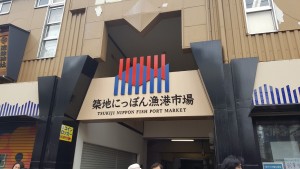
For this report interviewing a fellow researcher, I spoke with Otsuka-san, a second year Ph.D. student in Maruyama-sensei’s lab and my next-door desk neighbor. He has been at the University of Tokyo working in Maruyama-sensei’s lab for five years now, beginning when he was a B4 undergraduate student. He majored in mechanical engineering, though he considers his current work with CNT transistors to be more materials or electrical science. He says he can’t really remember why he decided to go into mechanical engineering, but he thinks it might have been because he liked science but wanted an easier major within that. (Although it’s funny to think of mechanical engineering as the easier major). However, he did have an intuition early on that mechanical engineering might not be completely what he wanted; later, he realized that mechanical engineering was too tied to industry, while he preferred basic/fundamental research. That’s why he’s glad he started in Maruyama-sensei’s lab—although it’s in the mechanical engineering department, the research is more like materials science. For the future, he plans on continuing on in academia and eventually becoming a professor.
Otsuka-san really enjoys his working environment in Maruyama-sensei’s lab. At least for his work, he has much freedom with which direction his research takes. Because it is such a large lab, we have many resources available and all of the equipment he needs can be found in one place.
For international experience, Otsuka-san has studied in Finland and America. In Finland, he studied for about a month in the
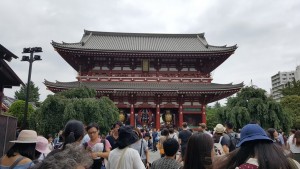
lab of Esko Kauppinen, home of the famous Esko CNT films. Then last year, Otsuka-san went to Duke University for 6 months to work on SWNT transparent conductive films and their application in touch panel displays and windows with adjustable transparency. He says that working in different countries has shown him different styles of lab environments, each with its good and its bad qualities. For example, people in Japanese labs tend to work long hours, even if they are not getting much done; he thinks this is because the Japanese work environment is more group-oriented, so the easiest way to distinguish people’s efforts is by the time they put in. On the flip side, he thinks America cares more about output than input, so as long as there are good results, you can finish as quickly as you can. As far as Finnish labs, he likes that they work shorter, more regular hours, but still manage to produce good work; although he thinks he could benefit from this schedule of taking breaks, he still thinks it’d be hard to adjust after being used to working so long. As for international researchers in Japanese labs, he thinks they tend to be very hard-working and able to give a different perspective; however, he would like to see scholarships for Japanese students to a more similar extent as what international students are able to get.
Although Otsuka-san spent time in the U.S, he still had questions about America and my perspective on it. But then we started talking for a while, so I can’t completely remember all of his questions or answers. However, I do remember him asking about whether students treat school and activities like tasks they have to do or things they want to do. He said he’s felt frustrated before with Japanese students who learn just for the test or participate in activities just to get into schools. When he said this, I thought about all the times I had felt this same frustration with some American students; however, I did say I thought people tended to become more passionate about their work as they got older, from high school to college to graduate school, as people’s focuses narrow and they choose what interests them.
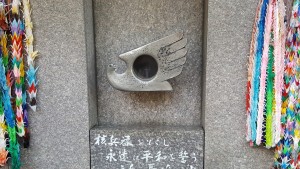
Question of the Week
At what point does your extensive onigiri-eating habit cross over into an actual addiction?
Research Project Update
This week, I moved forward with the other variations of the process using Au, including sputtering Co, dip-coating Co/Mo, and trying etching before CVD.
Firstly, I annealed more Au film samples (10 nm, 20 nm, 30 nm) at 500C for their different island morphologies. Checking the SEM, these annealed samples showed consistency in morphology with the annealed samples from last week.
For the first variation of the process, I accordingly sputtered 0.3 nm Co onto one substrate of each annealed Au film thickness, and then did CVD to grow SWNTs. The SEM showed actually less growth on the sputtered samples than last week’s dip-coated Co samples. However, like the other samples, the 10 nm Au had shrunk again to small-scale particles. Also, the 20 nm Au again showed the best growth of the three, although less than the dip-coated Co on 20 nm Au. There were some holes around the Au islands, possibly due to further island shrinking during CVD. In contrast to the dip-coated Co 20 nm Au, this sputtered 20 nm Au had more continuous Au film remaining after CVD, and clumped less into islands. Similarly, the sputtered Co 30 nm Au sample also showed less breakage of the Au film. There appears to be a particle film within the SWNT film, similar to the one observed in some Cu samples. It is possible that the Au also evaporates and re-condenses as small particles on the substrate.
For the next variation of the process, I dip-coated annealed Au films into Co/Mo as the catalyst, instead of just Co. I then grew SWNTs using CVD on these substrates. The SEM showed that the Au 10 nm had an interesting morphology, with particles in the back forming a film (probably Au). However, the SWNTs seem to be growing above it. The 20 nm Au again clumped into Au islands and SWNT film around. The 20 nm Au film showed good growth with uniform film, although slightly less dense towards the edges of the substrate. It was interesting to see that SWNTs are growing not only around, but over and across the Au particles. Finally, the 30 nm Au showed more of a continuous film with holes than an island morphology. We can observe SWNT growth behind this film, growing and poking out of the holes.
I learned how to etch Au using KI/I2 from Otsuka-san (the lab-mate I interviewed). Although it turns out that the etching is very simple, so he pretty much just told me what quantities of each to add and to sonicate, after which it’s ready for etching. I then etched the 10 nm Au CoMo dip-coated sample (that had already grown SWNTs). We chose this sample as one of the not-so-good ones, in case the etching did not go well. Just looking at the substrate after etching, it appeared that the film no longer looked uniform, although the overall appearance changed to tell the Au was removed. To dry, I placed in the CVD furnace to anneal 175C for 30 min (under Ar). Afterwards looking under the SEM, the Au appeared to be removed and left behind a sort of indentation pattern. The SWNTs remained, although there seemed to be problems with uniformity. Just as after the FeCl3 etching of SWNT/Cu films, there were some barren regions, and other carbon regions that appear darker on the SEM, appearing more like dense growth and craters.
The third variation of the process we tried this week was etching Au before growth. For this, I annealed more 20 nm Au films at 500C (instead of all three thicknesses) because it is consistently the most promising result, and we didn’t want to waste time with the other samples, as we are needing to do characterization soon. On one of these annealed 20 nm Au films, I again sputtered 0.3 nm Co. I also annealed the sputtered Co in air (to make it more uniform) but also to oxidize the Co, so that it is not removed during Au etching. I dip-coated the other annealed 20 nm Au film in Co solution to try with this process. Next, I etched the Au from the sputtered Co and dip-coated Co samples using the KI/I2 solution. Because there were not already SWNTs on the substrate, and we were just going to do CVD after, I did not anneal like the other sample, but just blew with N2 to blow-dry the water. Finally, I grew SWNTs on both etched substrates (along with a normal Co/Mo reference sample) using CVD.
Observing the samples in the SEM, it was exciting to observe SWNT growth! This was the first time we successfully etched the metal mask before SWNT growth. Although we were able to etch the Au without removing the Co, I think we need to further improve the morphology. The sputtered Co showed holes in the film that were not very large, probably because the SWNTs grew across/flopped over. The result was more of a patchy film than clearly-defined film with holes. The dip-coated Co showed perhaps slightly bigger holes than the sputtered Co film, but still patchy mainly.
However, because we are nearing the end, we are going to go ahead and grow using this process on quartz substrates (instead of Si/SiO2) so we can go ahead and do some characterization of the films for transmittance, sheet resistance, and Raman spectroscopy. Perhaps if there is time, we can continue modifying the process for larger holes/pocket size.
Week 11: Critical Incident Analysis – In the Lab

For my lab critical incident analysis, I decided to reflect on a situation with a miscommunication between myself, my mentor, and another lab member. One night towards the middle of the summer, I was working on using the vacuum evaporator to deposit thin films of gold onto my substrates. I wanted to get all of the samples deposited so I could move on to the next step in the process for the next day, and doing all the deposition in one go saves some time by only going through the shut on/shut off once.
However, I ran out of metal during the last deposition and had to restart the process to deposit the remaining 5 nm of Au. I wasn’t really thinking about what time it was, although it was starting to get late. While I restarted the deposition, my mentor asked if I would make the last train. I then remembered that shutdown involves a 40-minute cooling process that would put me close to missing the last train. I asked how long he would be at lab, and he said probably all night. (Wow.) So I asked if he could shut down the machine, which was a few steps at the end of the 40-minute cool down, although he had not operated that particular machine before. He agreed, and I made it the station to catch a train.
The next morning, I went back to the machine because I had forgotten to put the extra heater back on top, but the pressure did not decrease like it was supposed to. I looked at the machine log for previous users, and although it was relatively early, I found one of the people working in the lab. I asked if he knew what was happening, but after taking a look, he didn’t know either. I went back up to the office rooms to ask the main lab professor who always came in early, but then I saw the lab mate who had taught me how to use the machine. I asked him about the problem, and he offered to go downstairs to see what was happening with it. He looked around and realized that one of the valves was not open fully enough to prevent oil leak into the pump. He cleaned the oil from the pump to get the machine working properly again and explained what had happened. At this point, I realized that this valve-opening step was part of the shutdown I had left for my mentor.

While we all had positive intentions, miscommunication led to the mishap. While I just wanted to get as much done as possible, I should have realized that I could miss the train and saved the deposition for the next day. My mentor wanted to help me and allow me to get on the train. However, he was also busy with his own research and probably tired, which I should have thought about before asking him to help me with the shutdown. Even after I asked, I should have made him a note specifying to open the valve fully when asking him to shut down. I learned that asking for help is helpful, but I should be careful to make sure to give detailed instructions if they haven’t done it before. Additionally, I realized this trouble with the last train was probably because I am not used to relying on the schedule of public transit. This incident helped me learn to really watch the clock when working at the lab. Finally, I learned that it is important culturally for me to help others out, even if the task would be something outside my usual activities.
Question of the week: Seeing people reading on the subway made me wonder about literature in Japan. Do people usually read works originally written in Japanese, or is there a large market for translated works?

Research Project Update
This week, we used the last process we had tried to synthesize SWNTs on quartz so that we could characterize transmittance without having to transfer from the Si/SiO2 substrate. This involved depositing 20 nm Au onto the quartz using vacuum evaporation, annealing the Au at 500C, depositing Co once through dip-coating and once through sputtering, oxidizing, etching, and then growth. I also fabricated films using a standard, non-altered Co catalyst substrate with both dip-coating and sputtering Co for reference. We then characterized the samples using UV-vis-NIR for transmittance and the four-point probe method for sheet resistance. While the transmittance increased for the altered samples, the sheet resistance was much higher. We will try to address this by working to increase the quality of the SWNTs we are growing.
I also worked with Xiang Rong sensei in trying to make cleaner etched samples, because we worried that remaining metal affected the full growth of SWNTs. After etching, we tried sonication in water, sonication in ethanol, and etching again. While there was more complete removal of metal, the persistence of an unidentified particle film in the back could be problematic.
Simultaneously, we began a process to address the problem of SWNTs growing over the holes in the film. We tried to make larger holes in the SWNT film by using thicker films that would form larger islands. We decided to try a 100 nm Cu film, but ran out of metal during vacuum evaporation, so ended up with 83 nm Cu film. We first tried the previously used process of etching before growth, only annealing the metal film at a higher temperature 750C to form the island morphology necessary with the thicker film. SEM showed more well-defined holes, now 2-5 micrometers across (opposed to less than 1 micrometer before). However, we noticed a rough texture on the SWNTs though, probably indicating defects.
Return to Top
Week 12: Final Week at Research Lab

What has changed the most about your perceptions and attitudes towards Japan?
Japan is now less exoticized in my mind. Instead of a body of stereotypes, I’ve now replaced that with real faces and real people. Going in, I had the idea that everything would be weird and foreign. And while there were some weird things, it was much more normal than I was expecting. Additionally, the emphasis on politeness and decorum led me to think that everyone was too quiet and hard-working to joke around or have fun, but while everyone was polite and did work extremely hard, people still joked around and found time for a good laugh.
What has changed the most about your perceptions and attitudes towards the US?
Mainly, I’ve been reminded that the US is not all there is to the world. I used to think that once I was born in the US, I would always have to live in the US—moving abroad was only something I saw in movies. Now I can feasibly see myself living in another country for at least some portion of my adult life.
What has changed, if anything, about you personally? Are you a different in any way from when you first came to Japan?
I am more independent and more confident. I have stronger belief in myself to figure something out or get something done. I am also much more sensitive to others. I think about people’s motives and hidden meanings more than I did before, instead of taking things at face value. And thanks to the weekly reports, I even find I am significantly more introspective on a daily basis than I was before.

What were the most common daily frustrations you experienced with living in Japan? What did you learn from these experiences?
I hated feeling like a bother. I didn’t like inconveniencing others because of my own confusion and not knowing what was going on. I just really didn’t like the feeling of any of my incompetence affecting someone else, especially in the Japanese environment of consideration. Of course rarely would someone complain, but it still made me feel guilty—although people’s kindness and helpfulness did much to alleviate the frustration. The other slight discomfort about living in Japan was the staring. I tend not to be a center-of-attention kind of person, so when people have a tendency to look at you because you look foreign, it could get a little uncomfortable. However, I learned to just roll with it, and it became just another thing that I had grown accustomed to by the end of the summer.
What will you miss most about living and working in Japan?
Well firstly, konbinis. Secondly, ramen. Those were such amazing things that I take for granted now, such delicious food available on every block at all hours. I’ll miss the public transportation and walking culture. While I like to drive, it is definitely way more convenient to travel around Tokyo than it is around Houston. But above all, and I know it’s cheesy, I’ll miss the people. I’ll miss my lab mates, some very nice people who taught me so much, and I will miss working with them. I’ll miss the Japanese program staff who did so much to take care of us. And I’ll miss the other Nakatinis, and the incredible experience we were able to share together.
How did this experience affect your attitudes towards academic research and your career goals?
Before, I had considered going to graduate school, but I was not really sure how that process would work. This made me treat the idea more seriously, and gave me concrete steps toward bringing grad school into my future.

Describe your final week in the lab. What arrangements have you made to say goodbye to and thank your research group or those who have assisted you during your stay at your host institution? Did you have a going away party or other get-together before leaving your lab?
My lab actually threw me a farewell party the week before, in conjunction with a reception for a small conference. We had pizza and sushi like a classic Maruyama lab party, and it was nice to talk to both my lab members and the people visiting for the conference. One of the lab members, Mizutani-san, had drawn a farewell portrait for me with written goodbyes from everyone in the lab. It was such a nice gesture, and it reminded me of how fortunate I was to work with this lab. The whole thing made me feel nostalgic about leaving them, even if I didn’t get to know everyone as well as I would have wanted to. During my actual final week, I had breakfast with my lab mate Seo, before he left home for Korea. I was grateful for his companionship during the summer, and he was one of my lab mates most likely to ask for a meal or strike up a conversation, so I was quite sad to say goodbye. On the last day, I gave gifts to my mentors, professors, and secretary. While they were small gifts, I just wanted to give a small token of gratitude along with the thank-you letters I had written them. That last evening, my lab mates Mizutani-san, Ohyama-san, and Sota-san took me to get dinner for a final goodbye.
How did you close out your research project and do you plan to remain in contact with your research group and/or host? Do you plan to continue this research project or research in a related area upon your return to your home university?
As for closing out my research, there were a couple of things left to do, so Xiang Rong sensei was going to help me finish it out. I left all of my samples for him, and we continued emailing a bit after I had left the lab about the last experiment. There was talk about possibly continuing the project, but I think it has pretty much closed out after I left, as it was not directly tied to other groups’ research in the lab. I do plan on continuing research when I return to Rice, so I will look into the labs that Kono-sensei mentioned who do similar work with carbon nanotubes, especially CVD synthesis.
What are your plans for your final weekend in Japan?
Like many other of the fellows, I plan on climbing Mt. Fuji this last weekend!
Question of the Week: Do Japanese citizens tend to vacation within Japan, or do they travel outside the country frequently? It seems that with all of the regions in Japan promoting their unique attractions, there is a lot of tourism within the country itself. Combined with a history of isolation, I just wonder how common it is for outside travel.
Final Research Project Update
Title: Lithography-Free Fabrication of Transparent Conductive Single-Walled Carbon Nanotube Films
Host lab: University of Tokyo, Mechanical Engineering Department, Maruyama-Chiashi Laboratory
Host Professor: Shigeo Maruyama-sensei
Mentors: Assistant Professor Xiang Rong sensei, Qian Yang, Clement Delacou
Introduction: Single-walled carbon nanotubes (SWNTs) have excellent electrical conductivity, flexibility, and mechanical strength. Consequently, they are a promising candidate material for transparent conductive films (TCFs), with applications in electronic displays and solar cells. However, maximal performance of transparency and conductivity is hindered by the trade-off relationship between both characteristics in regard to SWNT film density. One method of improving this balance is patterned growth of SWNT films into low-density regions favorable to transparency and other high-density regions favorable to conductivity. However, previous implementations of this method involve lithography or complex treatments that arrange the SWNTs into TCFs after growth. My project was to develop an easier and more efficient method of fabricating SWNT TCFs as-grown using self-assembled metal masks.
Approach: Our approach was to control areas of SWNT growth using thin films of metal to selectively deposit catalyst and therefore achieve selective SWNT growth. Beginning with a clean Si/SiO2 substrate, we deposit a thin film of metal copper or gold through sputtering or vacuum evaporation. We then anneal the metal films which clump to form an island morphology. These metal islands become our mask for catalyst deposition, in which we sputter cobalt onto the patterned metal substrate. Our process then diverged into two possible methods. The first method then removed the metal through chemical etching and finally grew SWNTs using alcohol catalytic chemical vapor deposition (ACCVD). The second method grew SWNTs directly on the catalyst/metal substrate, and etched the metal mask after as the final step.
Results and Discussion: On the workings of the fabrication process, we produced several conclusions. We can control the metal mask’s surface area coverage by varying the metal film thickness and annealing temperature. Additionally, use of low-temperature oxidation allows for metal etching before SWNT growth, by protecting cobalt catalyst from reacting with etchant. However, the pre-growth etching process may still affect catalyst efficiency.
On the film morphology itself, our film with holes did increase transparency, but also decreased conductivity. However, it is unclear whether the compromised catalyst’s low yield could be the cause of low conductivity, rather than the film morphology itself.
Future Research: Firstly, further investigation should determine a more effective method to protect Co catalyst during fabrication. We should also improve SWNT quality overall to increase conductivity. Finally, the SWNT TCF’s efficiency should be demonstrated in a solar cell application.
Conclusion: Our project proved the ability of thin metal films to pattern SWNT growth by masking catalyst deposition. While our process was able to increase transparency, it did so at the cost of decreased conductivity. Should the conductivity of our SWNTs be increased through longer and more crystalline nanotubes, our process could prove effective for our goal of transparency with maintained conductivity.
Return to Top
Week 13: Final Report
The Re-Entry Program was helpful for adjusting back to being in America, which really did feel a little weird at first to be back, especially in Houston. It was interesting to notice different things than before, from the spaced-out buildings to the return to being treated like everyone else. Right when we stepped off the plane, I had a new-found appreciation for the airport signs written in both English and Spanish, especially coming from someone who relied so frequently on the English-translated Japanese signs. As for the Re-Entry programming itself, the talks were helpful for a variety of topics, but personally I thought it most useful for the presentation coaching we received for our posters and the information on graduate school. We received plenty of relevant advice from experienced people, which gave me a more concrete idea of what applying and attending graduate school would be like. Although grad school was a possibility for me before, I really felt that the research experience in combination with the program discussion has made it a more realistic option for my future.

The research poster presentations at the SCI Colloquium were more fun than I expected. I was a little worried because few people came by my poster at first, but it picked up after a while and the hour and a half was over before I knew it. I thought the most difficult aspect was fielding multiple people at once, especially when they came in at different times or had differing levels of expertise. Some people had interesting feedback or suggestions for improving various parts of the project. Aside from our own poster presentations, I also enjoyed watching the graduate students’ oral presentations, both for their research content and to observe their presentation styles and note which certain talks I found especially effective.
For our last day of fun, I was very excited that I finally went to NASA after already living in Houston for a year. Kono-sensei also threw a lovely party at his house on the final night. However, it really was sad to say goodbye to all of the U.S. Fellows. I made some close bonds with other Nakatinis, and it was disappointing to part with the faces who had been my go-to for the past 13 weeks. I think I felt especially close to the co-fellows because we were displaced into such a foreign situation, and having someone who knows pretty much what you’re going through really brings you closer. I thought it funny that I’d go across the globe to figure out just how reassuring it is to interact with people who share experiences in common.
When speaking to a family member about my Nakatani RIES experience, I’d say the most important thing I learned was how to be comfortable with unclear situations and be able to deal with things as they come. I also got a better idea of how to live independently and have to sort out situations on my own. And of course, I love talking to family members about what I learned in terms of another culture’s language, values, and customs. It’s one of those neat opportunities to have such a quickly expanded view of another people and be able to share that with my sisters or grandparents.

When speaking to a professor, I would say the most important thing I learned was hands-on practice with research techniques. I have an infinitely more defined idea of what to expect from doing research or attending graduate school, along with technical experience using material synthesis processes including sputtering, vacuum evaporation, alcohol catalytic chemical vapor deposition, and the characterization methods of UV-vis-NIR spectroscopy and four-point probe sheet resistance method. Additionally, the science lectures at the beginning of the program introduced me to quantum mechanics and other modern physics topics I hadn’t covered yet.
When speaking to an employer, I would say the most important thing I learned was how to work hard and be persistent. When something in our process didn’t work, we would have to identify the problem, find a solution to work around it, and try again. Additionally, I learned how to work with people from other cultures, not just Japanese but also Chinese and others. I learned how to work in ambiguous situations, either clarifying with someone or figuring something out independently. I practiced extended problem-solving, both in research and in regard to the mishaps that pop up from living in a foreign country. I am now more observant in picking up on cues and have become more sensitive to my surroundings.
When speaking to another student at my university, the most important things I would say are pretty much just the two main goals of the program: how to do scientific research and how to live in a foreign country. It’s hard to answer the frequent and classic “How-was-Japan” question, but I definitely answer this most frequently when speaking to other Rice students. I usually end up saying pretty much a combination of all the other things I’d said for other groups.
As a result of this program, I will most likely continue to engage in research. However, I am deciding whether I would like to continue with materials synthesis or more with application of these materials. Nakatani RIES has definitely increased my interest in future study abroad, especially in Asia. More than just traveling, I really enjoyed staying for an extended amount of time and actually working in a foreign environment. Interestingly enough, taking Japanese classes also refreshed my desire to improve my Spanish skills, so I will likely take classes at some point while at Rice. Struggling with language and the gratitude I felt when a Japanese person helped me out knowing English has made me want to pay it forward with speaking Spanish. Also as a result of this program, I think I will approach life differently in general. I already have caught myself being more tolerant or accepting of what people do; I think of what their background could be or where they could be coming from, that could possibly explain behavior that I’m not familiar with or wouldn’t expect.
Question of the Week: I know this is something I really could have asked someone while in Japan, but I wonder what Japanese people think of other countries’ stereotypes of themselves? (Especially the American idea that everything is cute)
Follow-on Project
At the beginning of the Fall 2016 semester, I helped Aki and Nickolas run the booth at the Discover Research Fair here at Rice. It was aimed towards new students but open to anyone interested in pursuing research. We handed out flyers and talked to fair-goers about general program information as well as our own experiences this summer. It was really nice to talk to prospective students and try to persuade them to apply to the program. It made me reflect on the program, and explaining to someone else why they should apply reminded me of just how amazing the program is, and all of the wonderful opportunities I had this summer. I think I sometimes I take for granted just how amazing my experiences were.
Additionally, I plan to join a mentorship program this year called Rice Empower, aimed at encouraging high school students to become interested in STEM fields and increase their access both to STEM in general and in future higher education. Working with these students, I will definitely tell them about the great opportunities available to STEM students for studying abroad, especially Nakatani RIES.
Return to Top
Tips for Future Participants
Pre-Departure: I wish I had gotten the JR Pass for traveling! Transportation could get pretty expensive, so I think it would be worth it to invest in one of these passes. Also decide in advance whether you’re climbing Mt. Fuji. I didn’t think I would, but ended up wanting to and really enjoying it! However, that meant I was unprepared and had to buy hiking shoes there and ended up just wearing a grossly large number of layers of regular clothes to stay warm. As far as packing, I would have to say that I swore by my pair of sensible shoes throughout my summer in Japan. As long as you get over the fact that you are wearing unfashionable blobs while surrounded by the most stylish people I’ve ever seen, I think it was definitely worth it. I got some nice clog-like shoes that slip on and off easily (good both for Japanese custom and the lab clean room). Similarly, I swore by my lovely collection of linen pants, which while again might not be the most sightly, saved me from dying in jeans or feeling out of place in shorts. Finally, read up on where you want to travel so you can start making a plan for your weekends!
Orientation: Find time to study the Japanese you learn in class! It makes it easier to progress through the material if you don’t forget what you did two days ago. Although it’s hard, try to find time to sleep. Things are fun, but less so if you’re dead inside.
Mid-Program Meeting: Get pumped for it! It really helped me get through the last week before the meeting to get excited for the weekend! Try to go early to do some more sight-seeing in that city or the surrounding area. The mid-program meeting presentation is a good opportunity to solidify your goals for your research project. Really use the oral presentation as good practice for giving talks, especially for future poster presentation!
Working with research lab: I at times struggled socializing with my lab. It can be hard to put yourself out there when everyone seems very busy. One thing that helped was one of the students was more directly outgoing, and he kind of worked like a gateway into interacting with the other lab mates. I wish I had been even more outgoing about asking them to do things, instead of just saying yes when they asked if I wanted to do things. As far as your actual lab work, I think the best advice I got, and the best advice I could give, is just come with an open mind and a dedication to working hard and learning as much as you can.
Living in Tokyo: I really recommend going out at different times of the day and walking around. It is very interesting to see the morning bustle versus the staggering people on Friday nights, or the families strolling on Sunday mornings. One activity I actually really recommend is pulling an all-night karaoke stint! It is a proud moment to see the sun rise on a full night of loudly singing stress relief. I recommend going back to places as well. While it is tempting to never go back to the same place because you want to do as much as possible, I appreciated when I could go see the same sight or experience the same place because there was always something new to feel.
Language Study: Mnemonics are wonderful for those kana! I suggest coming up with your own memory tricks (rather than using pre-made ones) because they stuck better for my brain, as I made my own weird connections. I suggest trying to learn kanji as well, because it is useful to have at least a basic idea of what written Japanese is saying. I recommend the Kanji Study App, because it is fun to use, almost like a game. While I was in the lab and waiting for something to finish, I would do the drawing quizzes for the kanji characters and it really felt like a fun drawing-skill game. I really recommend using your Japanese during your research internship period, which I was not always too good about doing. It’s easy to get stuck in a rut of the same words, but it’s a good idea to try speaking with Japanese people in conversations different from the inescapable greetings and requests.
What Gifts to Bring: I recommend going to your university bookstore and buying gifts there for your mentors and professors. For a lab-wide gift, Ozaki-sensei at Rice recommended Sandies cookies as a good little treat, and my lab members actually ended up really enjoying them at our first lab meeting.
What to Eat: Definitely try Japanese honey fruit water! It is the most delicious thing I have experienced, especially on a hot summer day. My favorite was yuzumitsu (Japanese lemon honey). Although I feel it’s inevitable, I recommend trying lots of ramen. Mainly, don’t be afraid to try new things!
What to Do: Sky Circus! If you want one of those Tokyo-views-from-a-skyscraper, but with an added optical illusion element, try this one out! We went with a group after touring around Ikebukuro and Sunshine City, and it ended up being a lot of fun. And a baseball game! A big group of fellows went to a Swallows game during orientation, and it was very enjoyable even as someone who isn’t super into sports.
